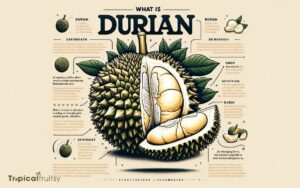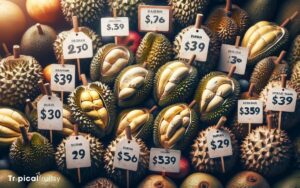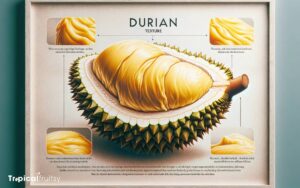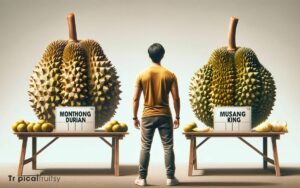What Animal Eats Durian Fruit? Nature’s Connoisseurs!
The durian fruit is consumed by a variety of animals including elephants, orangutans, wild pigs, several rodent species, fruit bats, civets, macaques, and various birds. These animals are attracted to its nutrient-rich flesh despite its strong odor and thorny husk.
Explanation Durian fruit plays an essential role in tropical ecosystems by offering nourishment to a diverse group of wildlife. Its consumption by animals helps in the natural process of seed dispersal, which is crucial for the propagation of durian trees.
The following points provide insights into the animal-durian relationship:
Durian fruit’s role in sustaining diverse wildlife demonstrates its ecological value beyond human culinary preferences.
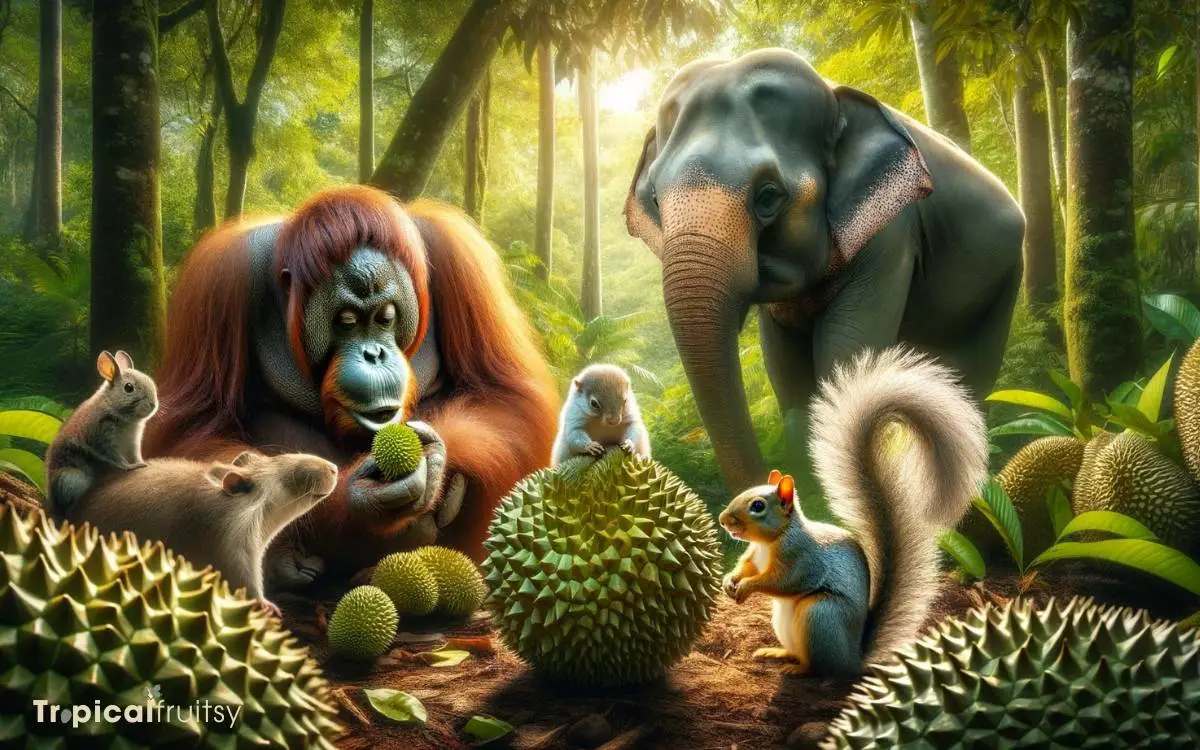
Key Takeaway
Animals That Eat Durian Fruit: An Ecological Perspective
| Animal | Attraction to Durian | Role in Durian Seed Dispersal |
|---|---|---|
| Elephants | Nutrient-rich flesh | Long-distance seed dispersal |
| Orangutans | High-calorie content | Seed dispersal through foraging |
| Wild Pigs | Calorie-dense flesh | Contribution to nutrient cycling |
| Rodents | Accessible food source | Localized seed dispersal |
| Fruit Bats | Intense smell | Night-time seed dispersal |
| Civets | Strong scent | Seed dispersal and processing |
| Macaques | Curiosity and taste | Sporadic seed dispersal |
| Birds | Variety in diet | Seed dispersal through droppings |
| Insects | Remnants of flesh | Decomposition and soil nutrient contribution |
The Mighty Elephants
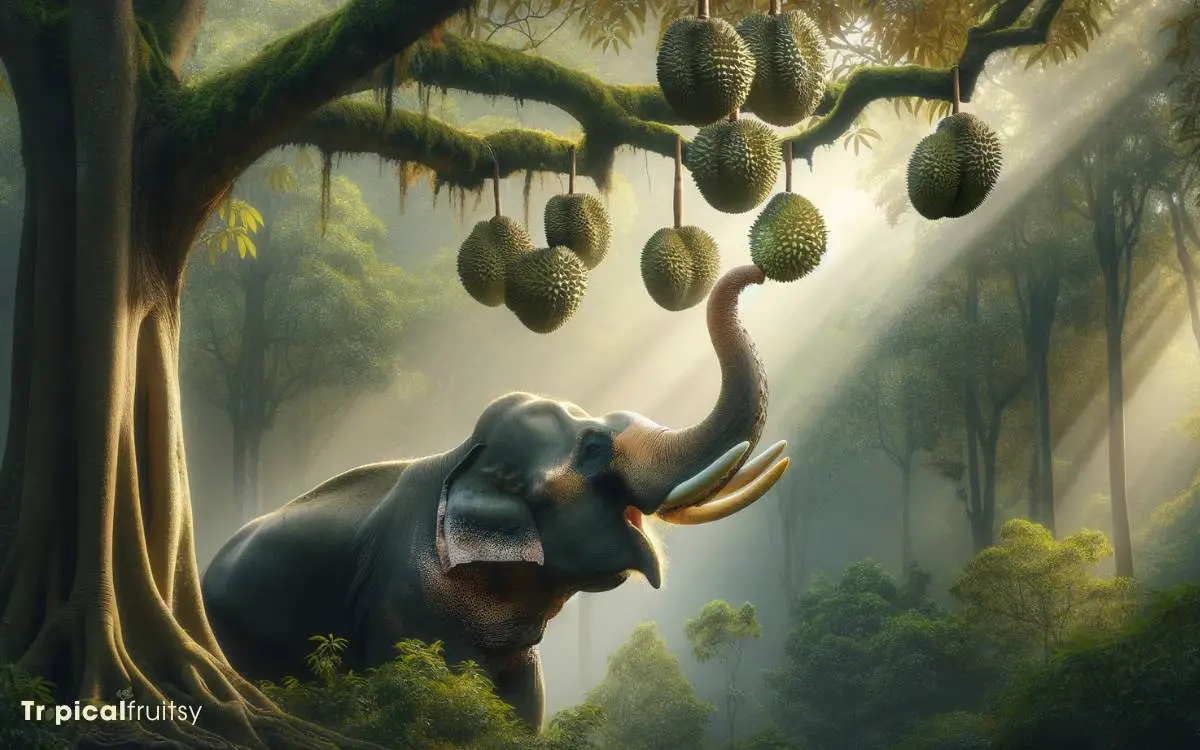
Elephants, with their versatile trunks and strong digestive systems, are known to consume durian fruit despite its formidable husk.
This behavior is not merely incidental but reflects an adaptation to a varied diet which can include a range of tough, fibrous, or thorny vegetation.
The pachyderms’ ability to process durian fruit is facilitated by their trunk’s dexterity, capable of maneuvering and exerting the necessary force to breach the thorny exterior.
Moreover, their digestive tract is robust, allowing them to digest the fruit efficiently, seeds and all, which in turn contributes to the dispersal of durian seeds throughout their habitat. This ecological interaction exemplifies the complex relationships within tropical ecosystems.
As we turn our attention to another forest dweller, the hungry orangutans also demonstrate fascinating dietary preferences.
Hungry Orangutans
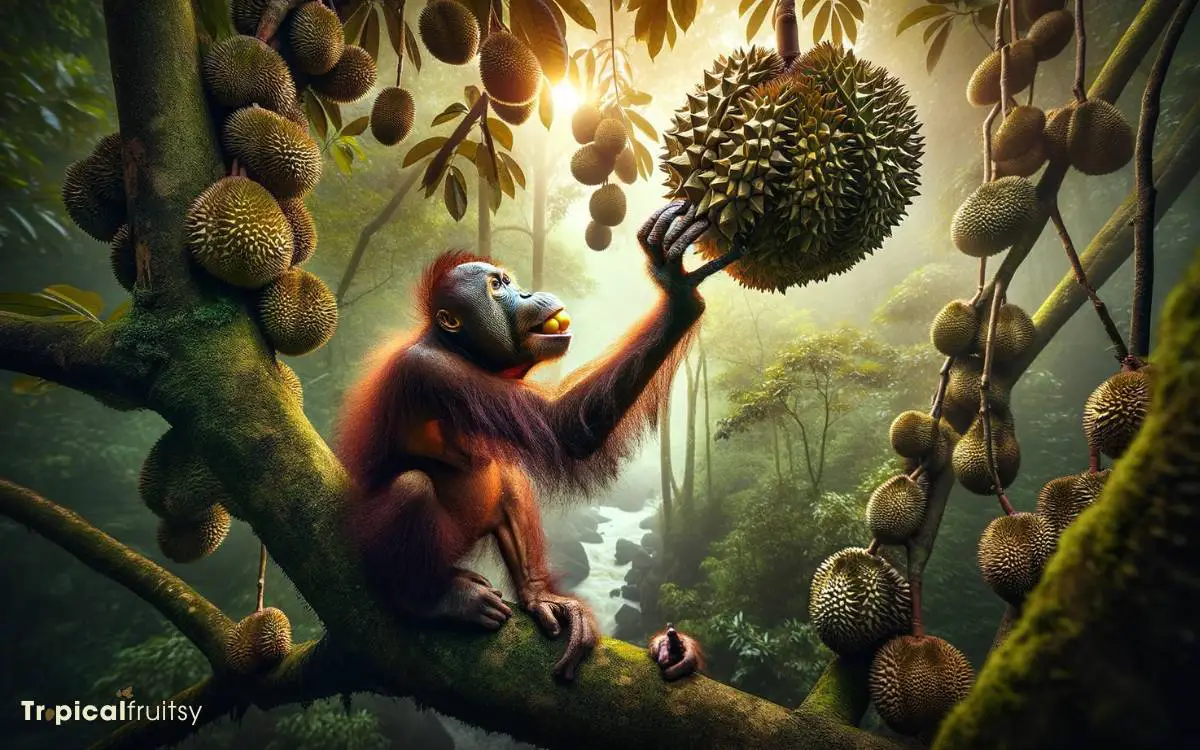
Orangutans’ fondness for durian fruit is well-documented, with these primates skillfully navigating the spiky exterior to reach the custard-like flesh inside.
Their ability to process the fruit’s formidable defenses is a testament to their intelligence and dexterity.
The consumption of durian by orangutans is not merely a dietary preference but also plays a role in seed dispersal, which is crucial for the survival of durian trees. The interaction is an elegant example of mutualism in the rainforest ecosystem.
- Orangutans deftly peel the spiny husk with their strong fingers and teeth
- They savor the rich, creamy texture of the durian’s interior
- Discarded seeds become new life as they germinate in the forest floor
This methodical approach to feeding underscores the ecological significance of orangutans within their habitats.
Foraging Wild Pigs
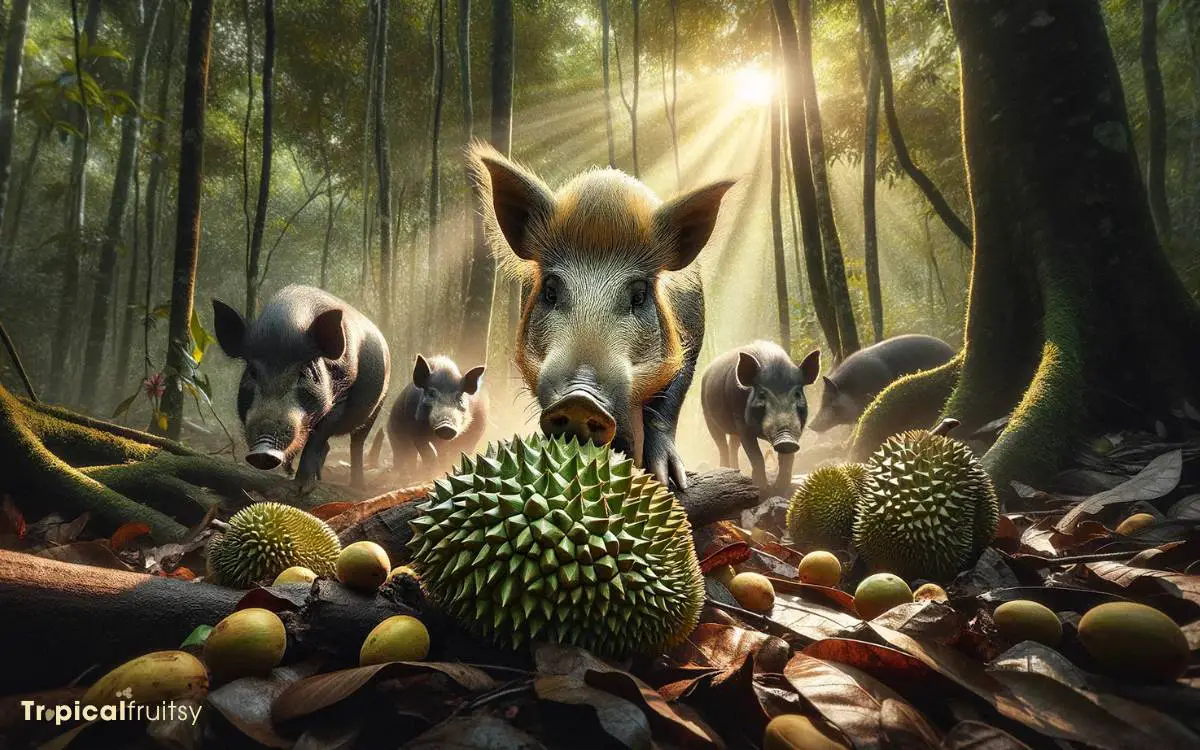
Wild pigs, known for their robust foraging habits, are also among the diverse group of animals that consume durian fruit, utilizing their keen sense of smell to locate these aromatic treasures in the dense forest underbrush.
These animals, scientifically referred to as Sus scrofa, engage in a behavior known as rooting, in which they use their snouts to dig into the soil and leaf litter to unearth food sources.
The durian’s pungent odor is a powerful olfactory signal for wild pigs, guiding them to the fallen fruits.
Upon discovery, they are capable of piercing the durian’s tough exterior to access the soft, edible pulp inside.
This foraging activity not only sustains the pigs but also plays a role in seed dispersal, contributing to the ecological dynamics of their habitat.
Opportunistic Rodents
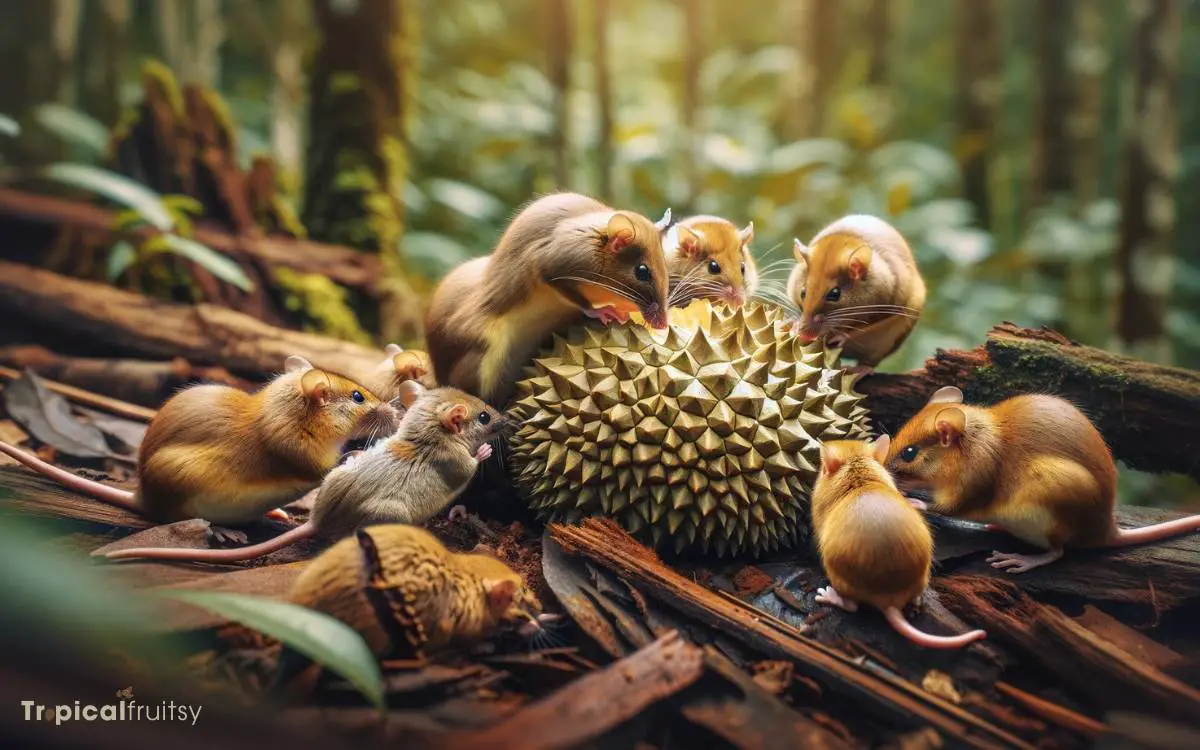
While wild pigs utilize their acute olfactory abilities to forage for durian, various species of rodents, such as rats and squirrels, also play a significant role as consumers of this fruit, capitalizing on their agility and keen sense of smell to locate and gnaw through the durian’s tough husk.
These rodents are opportunistic feeders, and their interaction with durian fruit can be characterized by the following observations:
- Agile movements of squirrels allow them to navigate the high branches where durians may be found.
- Incisors of rats are well-adapted for penetrating the formidable exterior of the durian.
- Rodent consumption patterns often lead to the scattering of seeds, aiding in the dissemination of the durian plant.
In a methodical examination of durian consumption, it is evident that these rodents are not merely pests but integral players in the ecosystem. As night falls, another group of animals, the fruit bats, emerge to partake in the durian feast.
Fruit Bats at Night
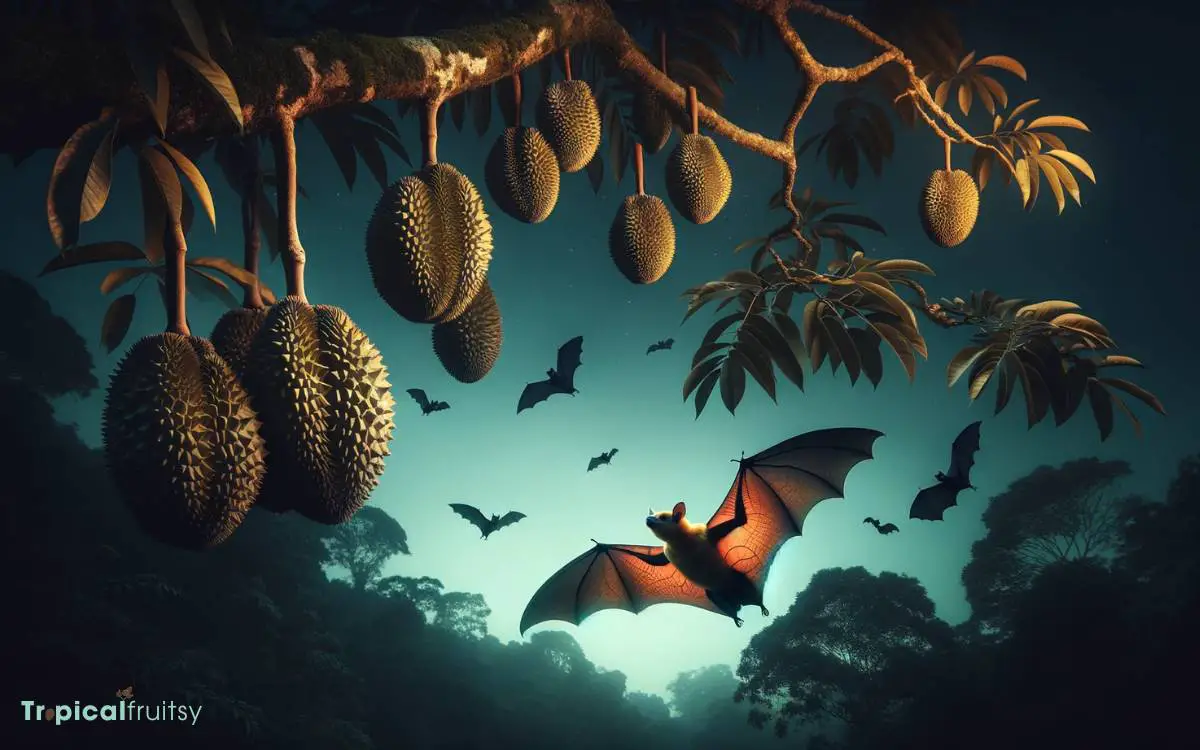
As nocturnal creatures, fruit bats exhibit specific feeding patterns that align with the night hours, which is particularly relevant when discussing their interaction with durian fruit.
The role of these mammals in pollination is crucial, as their movements during feeding facilitate the transfer of pollen between plants, thereby contributing to the reproductive success of species such as the durian.
Additionally, the pungent aroma of durian is a significant olfactory cue that attracts fruit bats, indicating a symbiotic relationship where the fruit’s scent is evolved to signal ripeness to potential bat dispersers.
Nocturnal Feeding Habits
Among the various animals that partake in durian fruit, several species of fruit bats, which are nocturnal feeders, play a crucial role in the fruit’s seed dispersal.
These mammals exploit the cover of darkness to approach and consume the fruit, effectively aiding in the propagation of durian trees.
Their nocturnal feeding habits are characterized by silent flight patterns that enable stealthy movement between durian trees. They also possess acute olfactory senses to locate ripe durians in the dead of night.
Additionally, fruit bats have efficient seed digestion and dispersal mechanisms that ensure the spread of durian plants across vast areas.
Through methodical observation and analysis, researchers have confirmed the significance of these nightly forays.
This symbiotic relationship underscores the importance of fruit bats beyond mere consumption, as they are also instrumental in durian pollination, a topic that merits further exploration.
Bat Pollination Role
How do fruit bats contribute to durian pollination during their nocturnal activities?
As nocturnal mammals, fruit bats perform a critical ecological service by facilitating cross-pollination of durian flowers.
These flowers bloom at night, emitting strong odors to attract their primary pollinators. Bats, equipped with keen olfactory senses, locate these flowers and feed on their nectar.
In the process, the bats inadvertently collect pollen on their fur. As they move from flower to flower, they effectively transfer this pollen, ensuring genetic diversity and successful fertilization of the durian plants.
This symbiotic relationship underscores the bats’ role in sustaining durian populations, which, in turn, supports the bats’ dietary needs. Therefore, the conservation of bat habitats is vital for the continued proliferation of durian fruit.
Durian Scent Attraction
While fruit bats are lured by the durian flower’s nocturnal emissions for pollination purposes, the fruit’s distinctive scent also plays a crucial role in attracting these animals when it ripens and falls to the ground.
The bats, equipped with a keen sense of smell, navigate the night skies drawn by the potent aroma. This olfactory cue is pivotal for the bats, as it signals a nutritious food source, crucial for their survival and energy needs.
- Pungent Invitation: The durian fruit emits a strong, sulfurous odor that can permeate the dense forest canopy, acting as a beacon for fruit bats.
- Nocturnal Foraging: Under the cloak of darkness, fruit bats employ their olfactory guidance to locate and consume ripe durians.
- Ecological Interaction: This scent-driven attraction facilitates the durian’s seed dispersal, underpinning a key ecological service provided by the fruit bats.
Inquisitive Macaques
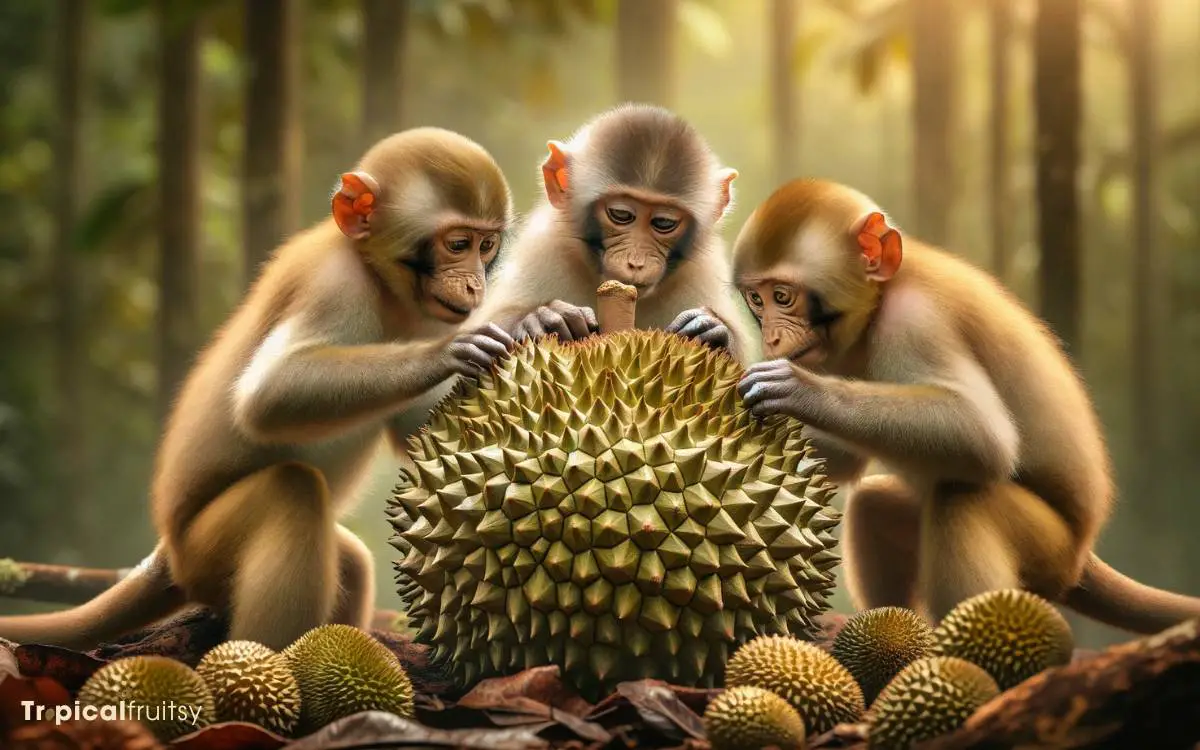
Macaques, known for their broad diet, have demonstrated a particular affinity for durian fruit, integrating it into their dietary repertoire.
Research suggests that the strong odor of durian, often repulsive to humans, acts as an attractant for these primates, guiding their foraging behavior.
An examination of macaques’ interaction with durian thus provides insights into the complexities of their foraging strategies and dietary preferences.
Macaques’ Durian Diet
Several species of macaques have been observed incorporating the formidable durian fruit into their diet.
Despite the durian’s tough exterior and pungent odor, these primates have developed sophisticated methods to access the nutritious pulp inside.
Their dietary adaptation to durian consumption is a compelling subject for ethological study as it demonstrates complex behavior in the face of ecological challenges.
- Dexterous Handling: Macaques use their nimble fingers to navigate the durian’s spiky shell, skillfully avoiding injury.
- Selective Feeding: They exhibit a preference for certain durian types, suggesting a discerning palate.
- Social Learning: Younger macaques learn to consume durians by observing and mimicking the actions of older group members.
This dietary inclusion reflects the macaques’ ability to exploit diverse food resources within their environment, showcasing their behavioral flexibility and cognitive prowess.
Durian Odor Attraction
The pungent aroma of durian fruit, surprisingly, acts as an olfactory beacon for a number of inquisitive macaques, drawing them to this unconventional food source.
These primates display a curious contradiction; despite the fruit’s overpowering odor, which is often repellant to humans, macaques are enticed to explore and consume it.
Scientific investigation into this phenomenon suggests that the macaques’ sense of smell, which differs from that of humans, may interpret the durian’s scent as an indicator of high caloric content and nutritional value, essential for their survival and well-being.
This attraction to the durian’s odor underscores the complexity of ecological interactions and dietary preferences among wildlife.
Feasting Civets
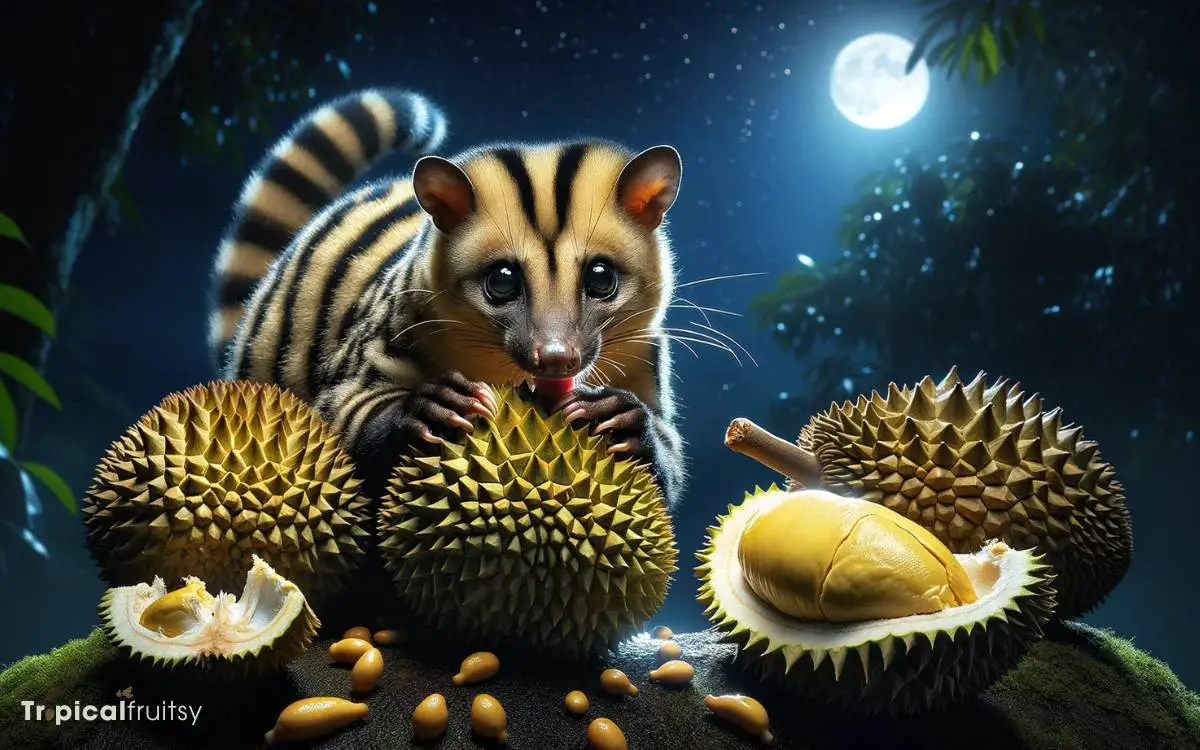
Fascination with the durian fruit extends to the animal kingdom, where civets are known for their penchant for the pungent delicacy. These nocturnal mammals engage in a symbiotic relationship with durian trees, playing a crucial role in seed dispersal.
Civets are attracted to the fruit’s strong aroma, which they can detect from a distance, using their acute sense of smell.
To create imagery in the audience’s mind:
- A civet gingerly climbing a tree, its eyes gleaming with anticipation.
- The creature’s sharp teeth piercing the durian’s tough exterior, revealing the creamy flesh inside.
- Seeds being discarded or excreted away from the parent tree, promoting forest diversity.
This ecological interaction highlights the importance of civets in their natural habitats and underscores the complexities of food web interactions.
Birds and Durian
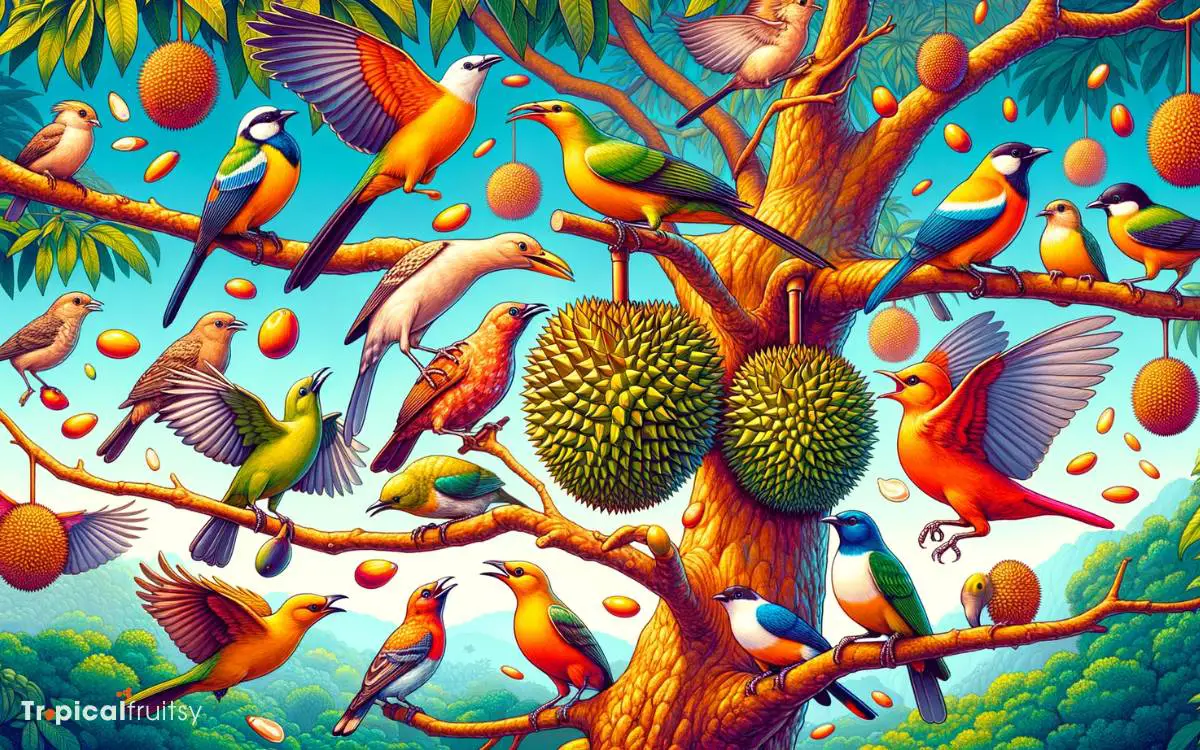
Birds’ dietary habits also include the consumption of durian fruit, contributing to the spread of its seeds through their droppings.
The interaction between avian species and durian plants exemplifies a mutualistic relationship, where birds benefit from the nutritional value of the fruit, while durians receive the advantage of seed dispersal.
Ornithological studies suggest that larger birds, capable of handling the substantial size and robust husk of durians, are primarily responsible for this dispersal.
The efficiency of seed spread by birds is contingent upon their foraging patterns, digestive processes, and flight range.
It is crucial to delineate which bird species are most involved in this ecological process to fully understand the dynamics of durian seed dissemination and the consequent implications for forest ecology and durian cultivation.
The Role of Insects
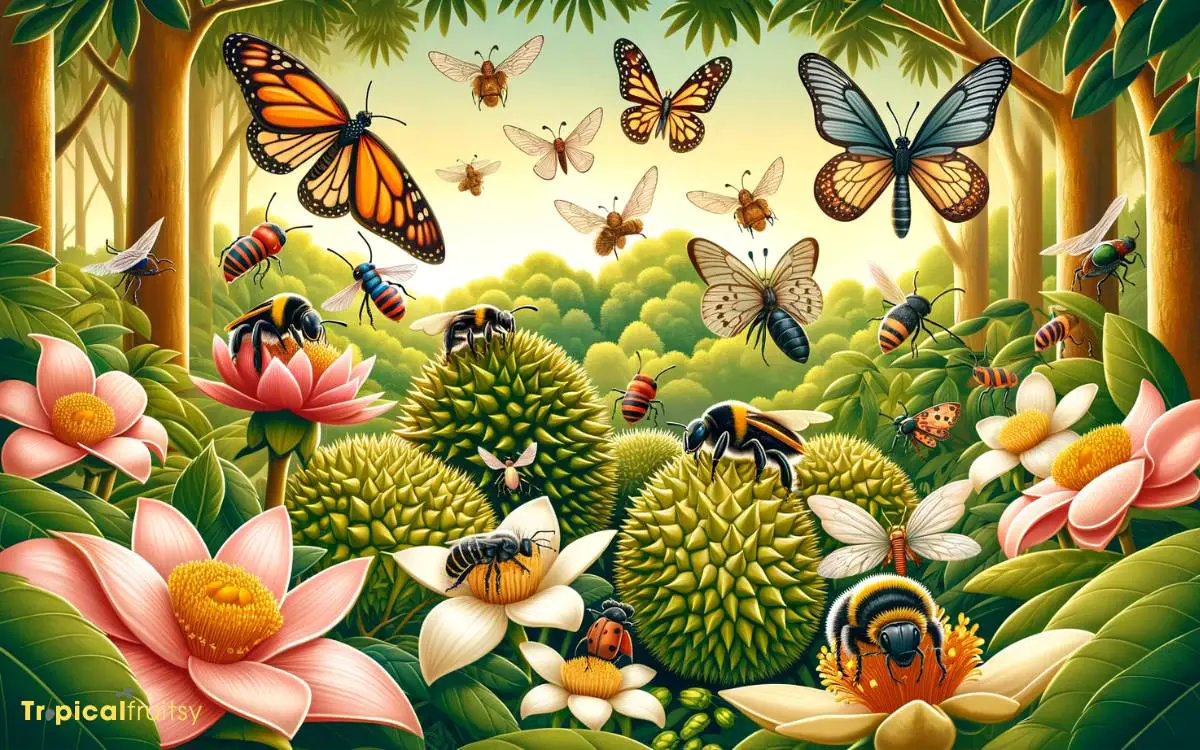
Insects play a crucial role in the pollination and consumption of durian fruit, with certain species specialized for penetrating its tough exterior.
While larger animals may be deterred by the durian’s formidable husk and pungent aroma, insects are equipped to navigate these challenges.
They not only facilitate the reproductive cycle of the durian by transporting pollen but also contribute to the breakdown and dispersal of the fruit’s seeds.
- Beetles: Burrowing into the flesh, they feast on the durian’s rich content, aiding in decomposition.
- Bees: Known to be primary pollinators, their inter-floral travels ensure successful pollination.
- Flies: Attracted to the durian’s scent, they lay eggs on the fruit, with emerging larvae feeding on the pulp.
This symbiotic relationship illustrates the intricate ecological dynamics between durian plants and insect communities.
Conclusion
An array of wildlife, ranging from the colossal elephants to the minute insects, partakes in the consumption of durian fruit, each playing a crucial role in the ecological tapestry.
These animals serve as seed dispersers, akin to the pieces of a puzzle that perfectly fit together to maintain the balance of their habitats.
The interdependence between durian fruit and its consumers underscores the intricate symbiosis within tropical ecosystems.

